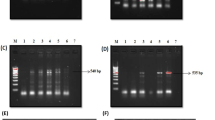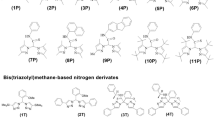Abstract
Organic salts of bismuth are currently used as antimicrobial agents against Helicobacter pylori. This study evaluated the antibacterial effect of elemental bismuth nanoparticles (Bi NPs) using a serial agar dilution method for the first time against different clinical isolates and a standard strain of H. pylori. The Bi NPs were biologically prepared and purified by a recently described method and subjected to further characterization by infrared spectroscopy and anti-H. pylori evaluation. Infrared spectroscopy results showed the presence of carboxyl functional groups on the surface of biogenic Bi NPs. These biogenic nanoparticles showed good antibacterial activity against all tested H. pylori strains. The resulting MICs varied between 60 and 100 μg/ml for clinical isolates of H. pylori and H. pylori (ATCC 26695). The antibacterial effect of bismuth ions was also tested against all test strains. The antimicrobial effect of Bi ions was lower than antimicrobial effect of bismuth in the form of elemental NPs. The effect of Bi NPs on metabolomic footprinting of H. pylori was further evaluated by 1H NMR spectroscopy. Exposure of H. pylori to an inhibitory concentration of Bi NPs (100 μg/ml) led to release of some metabolites such as acetate, formic acid, glutamate, valine, glycine, and uracil from bacteria into their supernatant. These findings confirm that these nanoparticles interfere with Krebs cycle, nucleotide, and amino acid metabolism and shows anti-H. pylori activity.




Similar content being viewed by others
References
Boisseau, P., & Loubaton, B. (2011). Nanomedicine, nanotechnology in medicine. CR Physics, 12, 620–636.
Roco, M. C. (2003). Nanotechnology: convergence with modern biology and medicine. Current Opinion Biotechnology, 14, 337–346.
Sahoo, S. K., Parveen, S., & Panda, J. J. (2007). The present and future of nanotechnology in human health care. Nanomedicine: Nanotechnology, Biology, and Medicine, 3, 20–31.
Arvizo, R. R., Bhattacharyya, S., Kudgus, R. A., Giri, K., Bhattacharya, R., & Mukherjee, P. (2012). Intrinsic therapeutic applications of noble metal nanoparticles: past, present, and future. Chemical Society Reviews, 41, 2943–2970.
Peng, H. I., & Miller, B. L. (2010). Recent advancements in optical DNA biosensors: exploiting the plasmonic effects of metal nanoparticles. Analyst, 136, 436–447.
Sau, T. K., Rogach, A. L., Jäckel, F., Klar, T. A., & Feldmann, J. (2010). Properties and applications of colloidal nonspherical noble metal nanoparticles. Advanced Materials, 22, 1805–1825.
Sokolov, K., Tam, J., Tam, J., Travis, K., Larson, T., Aaron, J., et al. (2009). Cancer imaging and therapy with metal nanoparticles. Conf Proc IEEE Eng Med Biol Soc, 2009, 2005–2007.
Dykman, L., & Khlebtsov, N. (2012). Gold nanoparticles in biomedical applications: recent advances and perspectives. Chemical Society Reviews, 41, 2256–2282.
Wang, D., Taylor, E. W., Wang, Y., Wan, X., & Zhang, J. (2012). Encapsulated nanoepigallocatechin-3-gallate and elemental selenium nanoparticles as paradigms for nanochemoprevention. International Journal of Nanomedicine, 7, 1711–1721.
Chen, R., Cheng, G., So, M. H., Wu, J., Lu, Z., Che, C. M., et al. (2010). Bismuth subcarbonate nanoparticles fabricated by water-in-oil microemulsion-assisted hydrothermal process exhibit anti-Helicobacter pylori properties. Materials Research Bulletin, 45, 654–658.
Chen, R., So, M. H., Yang, J., Deng, F., Che, C. M., & Sun, H. Z. (2006). Fabrication of bismuth subcarbonate nanotube arrays from bismuth citrate. Chemical Communications, 21, 2265–2267.
Sox, T. E., & Olson, C. A. (1998). Binding and killing of bacteria by bismuth subsalicylate. Antimicrobial Agents and Chemotherapy, 33, 2075–2082.
Stoltenberg, M., Martiny, M., Sorensen, K., Rungby, J., & Krogfelt, K. A. (2001). Histochemical tracing of bismuth in Helicobacter pylori after in vitro exposure to bismuth citrate. Scandinavian Journal of Gastroenterology, 2, 144–148.
Mahony, D. E., Lim-Morrison, S., Bryden, L., Faulkner, G., Hoffman, P. S., Agocs, L., et al. (1999). Antimicrobial activities of synthetic bismuth compounds against Clostridium difficile. Antimicrobiol Agents Chemother, 43, 582–588.
Salih, B. A. (2009). Helicobacter pylori infection in developing countries: the burden for how long? Saudi Journal of Gastroenterology, 15, 201–207.
Andersen, L. P., Colding, H., & Kristiansen, J. E. (2000). Potentiation of the action of metronidazole on Helicobacter pylori by omeprazole and bismuth subcitrate. International Journal of Antimicrobial Agents, 14, 231–234.
Chuah, S. K., Tsay, F. W., Hsu, P. I., & Wu, D. C. (2011). A new look at anti-Helicobacter pylori therapy. World Journal of Gastroenterology, 17, 3971–3975.
O’Connor, A., Gisbert, J. P., McNamara, D., & O’Morain, C. (2011). Treatment of Helicobacter pylori infection 2011. Helicobacter, 16(Suppl 1), 53–58.
P. Nazari, M. A. Faramarzi, Z. Sepehrizadeh, M. R. Mofid, R. D. Bazaz, A. R. Shahverdi. Biosynthesis of bismuth nanoparticles using Serratia marcescens isolated from the Caspian Sea and their characterization. IET Nanobiotechnology, 6: 58–62.
McLaren, A. (1997). Methods in molecular medicine. In C. Clayton & H. Mobley (Eds.), In vitro susceptibility testing of H. pylori (Vol. 8, pp. 41–51). Totowa:NJ: Humana Press Inc.
European committee for antimicrobial susceptibility testing (EUCAST). (2000). Determination of minimum inhibitory concentrations (MICs) of antibacterial agents by agar dilution. Clinical Microbiology and Infection, 6, 509–515.
Stratton, C. W., Warner, R., Coudron, P. E., & Lilly, N. (1999). Bismuth-mediated disruption of the glycocalyx-cell wall of Helicobacter pylori: ultrastructural evidence for a mechanism of action for bismuth salts. The Journal of Antimicrobial Chemotherapy, 43, 659–666.
Chen, Z., Zhou, Q., & Ge, R. (2012). Inhibition of fumarase by bismuth(III): implications for the tricarboxylic acid cycle as a potential target of bismuth drugs in Helicobacter pylori. BioMetals, 25, 95–102.
Ge, R., Sun, X., Gu, Q., Watt, R. M., Tanner, J. A., Wong, B. C., et al. (2007). A proteomic approach for the identification of bismuth binding proteins in Helicobacter pylori. Journal of Biological Inorganic Chemistry, 12, 831–842.
Acknowledgments
This work was supported by the Drug Design and Development Research Center, Tehran University of Medical Sciences, Tehran, Iran.
Conflict of Interest
The authors declare that they have no conflict of interest in this paper.
Author information
Authors and Affiliations
Corresponding author
Rights and permissions
About this article
Cite this article
Nazari, P., Dowlatabadi-Bazaz, R., Mofid, M.R. et al. The Antimicrobial Effects and Metabolomic Footprinting of Carboxyl-Capped Bismuth Nanoparticles Against Helicobacter pylori . Appl Biochem Biotechnol 172, 570–579 (2014). https://doi.org/10.1007/s12010-013-0571-x
Received:
Accepted:
Published:
Issue Date:
DOI: https://doi.org/10.1007/s12010-013-0571-x




